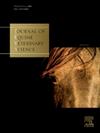阉割驴的时候该做什么?回顾性比较马拉维农村兽医学生阉割的261头驴精索出血的结扎方法,采用刺扎法和改良的米勒结扎法。
IF 1.6
3区 农林科学
Q2 VETERINARY SCIENCES
引用次数: 0
摘要
背景:与马相比,阉割驴的特殊考虑包括存在较大的阴囊血管,较大的睾丸动脉和静脉,以及随之而来的术后出血风险增加,这需要进行精索结扎。目的/目的:本回顾性研究比较了马拉维农村阉割驴的两种精索结扎方法之间出血并发症的发生率。方法:纳入所有在2020年2月至2024年8月期间到马拉维兽医教育/利隆圭动物保护和护理协会农村大型动物外展诊所进行阉割的驴,这些驴由接受过手术阉割培训的兽医学生进行阉割。从2020年2月至2024年2月,放置了一个穿孔绳,从2024年2月起放置了一个改良的磨坊结。记录年龄、体重和精索出血发生率。结果:纳入261头驴,中位年龄为4岁(四分位间距(IQR));3.5)。在更多使用穿刺术结扎的手术中记录了精索出血(6;3.8%,置信区间95% (CI): 0.7-7%),与放置改良的铣刀结的程序相比(0;0%, ci: 0-0%)。年龄或体重在治疗组之间或有和没有出血记录的病例之间没有显著差异。结论:本研究首次比较了驴精索结扎两种方法的结果。改良的磨坊结易于应用,提供了良好的止血作用,可以优先用于在阉割驴精索结扎的穿透结扎。本文章由计算机程序翻译,如有差异,请以英文原文为准。
What ‘knot’ to do whilst castrating donkeys. A retrospective comparison of ligation method on spermatic cord haemorrhage in 261 donkeys castrated by vet students in rural Malawi using transfixing and modified millers' ligatures
Background
Special considerations for donkeys undergoing castration compared with horses include the presence of large scrotal vessels, larger testicular artery and vein and the consequential increased risk of post-operative haemorrhage which necessitates spermatic cord ligation.
Aims/objectives
This retrospective study compares haemorrhagic complication rates between two methods of spermatic cord ligation in donkeys castrated in rural Malawi.
Methods
All donkeys presenting to Veterinary Education Malawi / Lilongwe Society for the Protection and Care of Animals rural large animal outreach clinics for castration between February 2020 and August 2024 that underwent castration, performed by veterinary studentswho had undergone training in surgical castration were included. From 02.2020-02.2024 a transfixing ligature was placed and from February 2024 a modified millers’ knot was placed. Age, weight and incidence of spermatic cord haemorrhage were recorded.
Results
Two-hundred-sixty-one donkeys were included, with a median age of 4 years (inter-quartile-range (IQR); 3.5). Spermatic cord haemorrhage was recorded during significantly more procedures where a transfixing ligature was placed (6; 3.8 %, confidence interval 95 % (CI): 0.7-7 %) compared with procedures where a modified millers’ knot was placed (0; 0 %, CI: 0-0 %). Age or weight did not significantly differ between treatment groups or between cases where haemorrhage was and was not recorded.
Conclusion
This is the first study to compare the outcomes between two methods of spermatic cord ligation in donkeys. The modified millers’ knot is easy to apply, provides excellent hemostasis and may be preferentially used over the transfixing ligature for ligation of the spermatic cord in donkeys undergoing castration.
求助全文
通过发布文献求助,成功后即可免费获取论文全文。
去求助
来源期刊

Journal of Equine Veterinary Science
农林科学-兽医学
CiteScore
2.70
自引率
7.70%
发文量
249
审稿时长
77 days
期刊介绍:
Journal of Equine Veterinary Science (JEVS) is an international publication designed for the practicing equine veterinarian, equine researcher, and other equine health care specialist. Published monthly, each issue of JEVS includes original research, reviews, case reports, short communications, and clinical techniques from leaders in the equine veterinary field, covering such topics as laminitis, reproduction, infectious disease, parasitology, behavior, podology, internal medicine, surgery and nutrition.
 求助内容:
求助内容: 应助结果提醒方式:
应助结果提醒方式:


